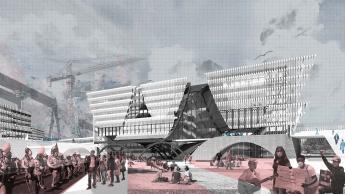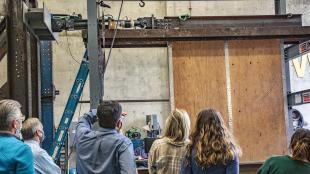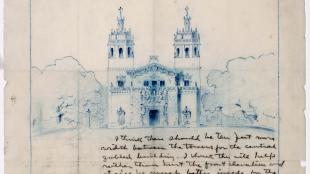Architecture Student Kaiyan Chen Earns Honors At The Steel Design National Competition

Kaiyan Chen—who hails from Zhuhai, Guangdong, China—had never set foot on campus at Cal Poly before conceptualizing a submission for the 2021 ACSA/AISC Steel Design Student Competition. This meant that as a transfer student attending classed remotely due to the pandemic, Chen managed to create the design for “Above & Below [The Veil],” a hybrid library and student union building for a newly proposed Historically Black College and University on an abandoned pier at the Port of Los Angeles, without the opportunity to visit the site, which is challenging for any designer who must gain an understanding of a place to envision its transformation.
“Students were asked to design a campus in scale similar to Cal Poly without any physical reference points or master plan,” says Cal Poly College of Architecture and Environmental Design Professor Thomas Fowler, who served as Chen’s instructor in the 24-week, comprehensive building-design studio where the project was developed. “The fact that Chen was able to overcome this and come up with a presentation that received national recognition was incredibly impressive.”
In addition to Chen’s submission, the 2021 ACSA/AISC Steel Design Student Competition recognized 18 exceptional projects in two categories, which explored a variety of design issues related to the use of steel in design and construction, offering upper-level architecture students from more than 60 colleges and universities across the U.S. and Canada the opportunity to develop project designs using steel as a primary material.
The judges were impressed by Chen’s concept for a unique truss design. “From a structural perspective,” they said, “the student fully grasps ideas on how trusses can be optimized.”

Chen created the concept by transforming a cultural map of Los Angeles, titled “Biggie, Biggie, Biggie,” which was created by Black artist Mark Bradford. “We understand the painting as a cityscape with two contrasting layers sitting above and below the grade,” said Chen of the final submission. “I combined that with W.E.B. Du Bois’ theory about the Double-Consciousness and decided that each layer represents one state of mind, with the grade serving as the discriminating ‘veil’ that prevents the two from being seen as one.”
Chen’s honorable mention-recognized design was drawn from a pool of competitors from institutions such as Auburn, Princeton, Syracuse, Texas A&M, Rochester Institute of Technology, and several UC campuses, including Berkeley.
“This was a particularly challenging project,” said Fowler. “It wasn’t only complicated by the remote learning design studio mode, but also because students were tasked with preparing a complete urban design proposal for a new campus design, focusing this environment on a hybrid library/student union building. Chen did an excellent job responding to all the challenges.”




